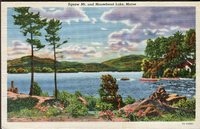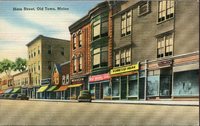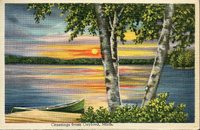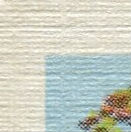Linen
The new ink-based dyes introduced in the late 1920s, which promised deep, vibrant color, didn't absorb quickly into regular cardstock, and the colors tended to dry with a dull, faded look, making the production of quality postcards during the Great Depression a drain on time and money.1 Printers added heat to the process to speed the drying time, but postcard stock still couldn't absorb enough of the dyes. Finally, in 1931 Curt Teich & Co. introduced their solution to the absorption problem: "linen" postcards.
This "new" material was actually still just paper, but with a twist—Teich embossed the surface of the cardstock with series of horizontal and vertical lines, creating a waffle-like pattern (left). From a distance, the cards appeared to have the texture of linen cloth, thus giving them the "linen" name. The key to this "new" material was the increased surface area: the many peaks and valleys of the embossed lines meant that there was much more material to absorb the ink, bringing the drying time down significantly while also preserving the inks' brilliant colors.
Many other postcard producers quickly followed in Curt Teich's footsteps and printed their own linen cards. Smaller publishers, not to be left behind, contracted out the printing of their linen postcards to Curt Teich & Co. and other industry giants. Some linen-finish postcards were produced as tinted halftones, while others used tricolor or CMYK process printing.2 The linen cards that dominated markets most were, of course, Curt Teich's C.T. Art-Colortone five-color (CMYK+1) process cards, particularly the large-letter "Greetings from..." cards.3 In total, postcard manufacturers printed over 100,000 unique views on linen-finish cards, with Curt Teich responsible for about half of them (roughly 45,000).4
Linen postcards are recognizable by their texture and vivid colors, as well as for their picturesque displays of nature and other scenes. Indeed, most linen postcards were heavily retouched to create these idyllic views that were "an optimistic response to the Great Depression's bleakest years"5 and "suggestive of a better future."6
These postcards proliferated throughout the United States from 1931 until about 1953. Though Curt Teich, and presumably other postcard publishers, continued to print linen-finish cards until 1959, a newer and more efficient printing method (Photochrome) brought about the decline of linen cards. However, many postcards collectors still seek out the vivid, picturesque cards.
Footnotes
- Information in this and the following paragraph is taken from Jeffrey L. Meikle, Postcard America: Curt Teich and the Imaging of a Nation, 1931-1950 (Austin: University of Texas Press, 2016), 37-38, and Alan Petrulis, "Tricolor and Process Printing: Linen Postcards," MetroPostcard.com, http://www.metropostcard.com/tech4-linens.html (accessed September 1, 2018).
- Petrulis, "Tricolor and Process Printing: Linen Postcards."
- See http://collections.carli.illinois.edu/cdm/search/collection/nby_teich/searchterm/Large%20Letters--City/mode/exact from the Curt Teich Postcard Archives Digital Collection at the Newberry Library for examples of the large-letter "Greetings from..." postcards.
- Meikle, 5.
- Ibid., 35.
- John A. Jakle, quoted in Ibid.




